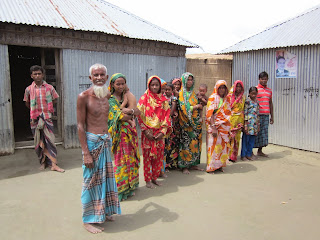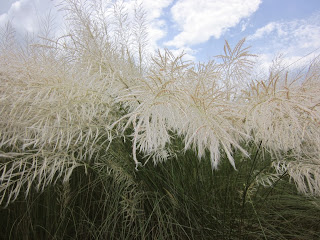 |
| The view across the Brahmaputra to Char Parbhotipur, Kurigram. |
 |
| Boat to Char Parbhotipur, Kurigram. |
In the city, with the
toys and trappings of building and car it’s easy to misperceive a gap between humankind
and nature. It’s easy to don the twin myths of security and control. But in the
Brahmaputra ’s realm a day is still a day.
In the promise of new land the perennial kans grass, the kashphul, congregates. It’s beauty. See the thin, hearty reed stems
in dusty green? Along the banks of the shifting sand shoals including Char
Parbhotipur in Kurigram, the kashphul makes the most of opportunity and
establishes its camp. It is at home in its burgeoning river-island colonies.
See the long spike of the kashphul leaf?
 |
| Kashphul and rooftops, Char Parbhotipur, Kurigram. |
Shining, soft and velvety is the kashphul wildflower. It beckons to be snuggled like a puffy pillow on a winter bed, the blossom field a lamb’s wool blanket, seemingly ready to challenge with a show of enthusiastic coolness the harsh sun of autumn’s midday. It’s to tickle the cheek; to set the heart dancing. The kashphul invites with its seasonal charms.
Mohammed Abu Taleb hardly considers the kashphul as he
strides up, in bare chest and blue lungee, from the shoreline. The spring in
his step has arrived with the unexpected sight of visitors. His hair and beard
are white. Has he been catching fish?
 |
| Mohammed Abu Taleb with family members. |
Into the earthen compound he’s scratched out of the
landscape he steps, into the yard made for a family of more than ten
individuals. With a broad kashphul smile, abba,
father, is returned home.
Society is not diverse in Char Parbhotipur. There isn’t an
established bazaar and just one small primary school; similarly it is for the
kashphul which has no intertwine companionship of the sort familiar to jungle
mahogany and vine. They are frontier dwellers, unlikely denizens of unsure
land, both strong and somehow accustomed in their vulnerability to the river’s
mood swings.
Wind wanderer, current rider, with not the width of paper
between the kashphul and nature’s choices: from the poverty of sand they rise.
 |
| Like the kashphul, the households are rising from the sand. |
Char Pabhotipur has been in the world for about seven years,
Mohammed Abu Taleb says. He was among the first to set his family there, three
years earlier after their former place of residence on another shoal was
returned to the Brahmaputra . It is not his
land and he pays no rent; yet it’s known he lives there. His is one of the two
hundred families that call Char Parbhotipur home.
See the strength and vulnerability in his body? He’s thin
but has the muscles of day labour. Cheerfully he tells of his striving, to the
fields of Feni to plant rice, to megacity Dhaka
for day labour, to the fields of Dinajpur for harvest. Wherever there is work
he will go and I suspect he enjoys travelling, even while carrying his day by
day thoughts of family and shoal – surely the weightiest item in his luggage.
There’s not the width of paper between his family’s future
and nature’s choices, he knows.
 |
| Kashphul makes wild sugar in the summer months. |
In the summer months of Boishakh and Jyoistho the finest
secret of the kashphul arrives. Of course the reeds are harvested for fences,
for thatch. The kashphul can make paper too. But in summer it’s the promise of
wild sugar that drives the harvest, with the new stems chosen, the horizontal
earth-aligned stems that are best for the task. The vertical stems which grow
later aren’t sweet, Mohammed Abu Taleb says.
Back at the house the stems are crushed by hand, covered
with cloth and squeezed, boiled, squeezed. The syrup is black and a little less
sweet than cane sugar. All the same the kashphul gift is an essence of sweet,
sweet river-life.
 |
| Rofiqul and Jolku with goat and sheep. |
Meanwhile Rofiqul walks with Jolku, who is bringing home his
one black goat and one white sheep from grazing. They’re passing through a white
kashphul short-cut, quite usual, unremarkable, and they’re holding one black
umbrella to shield from the Brahmaputran sun.
Meanwhile Nasib Uddin who has already reached seventy finds
no time for his retirement. With a basket of the gourd vegetable that’s called kadoa in Kurigram he is crossing the
char by foot, basket on head, in the hope of a boat. Char Parbhotipur has perhaps
as its singular advantage proximity to the mainland bazaar of Jatrapur. It’s
only twenty minutes across the water and his vegetables will sell there.
 |
| Nasib Uddin is taking his gourds to market. |
Nasib Uddin tended his kadoa crop for two months before the first harvest, he says, and for the two following months it will yield, he will collect the gourds as they mature. It’s innovation to grow vegetables on Char Parbhotipur – the next small step of settlement. With the proceeds in Jatrapur he will buy the daily food for his family, rice in particular. He has 15 kilograms to sell on that day, at a rate of ten taka per kilogram. It means survival.
Meanwhile Ambya is waiting for her husband. Part of her
thatched home is on stilts, where they can retreat with their belongings when
the water comes in. The mud floor, inside, is rough and still wet from rain or
river flow.
 |
| Ambya is waiting for her husband. |
 |
| Winnowing and pounding. |
 |
| Storage area on stilts. |
 |
| Ambya's kitchen. |
Mohammed Abu Taleb’s family has gathered to speak with the
visitors – women, young men, children – all ages, colourful clothes – they
share in common one kashphul smile, open-hearted and curious. They show a kula, a rice winnowing tray filled with
the dried young jute leaves that will make a dish, give meaning to rice, partly
because it is all they have to show. And they offer a glass of water because it
is all there is they have to offer. There isn’t even tea.
And it’s funny, you know, the kashful smiles – of a
brilliance barely known in the city. When asked if his family faces any
problems Mohammed Abu Taleb says automatically, surrounded by his full-of-love
family and driven by the excitement of visitors, “No, we are fine.” And it’s
funny because they are fine, more than fine – in that one singular moment,
except… to ask a little more…
 |
| Kashphul beyond the fence. |
“Well yes, the tube well for drinking water is far….”
“Well yes, there are no sanitary latrines…”
“Well yes, there’s no medical centre…”
And he shows us the mud line half-way up the fence beside
his house: “Oh and the house floods, but only about three times per year.”
The kashphul have no city hang-ups. They need no manicured
garden or balcony pot; there’s no service charge and they pay no rent. The
kashphul has no reason to deny that their existence is simply a fragile, passing
phase – it’s about sharing ground in this day and the next – to, in
congregation, enjoy the sun and feel the rain.
 |
| The waterline, three times a year, at Mohammed Abu Taleb's house. |
There’s not the width of paper between the kashphul and
nature’s choices – yet from the poverty of sand, just above the Brahmaputran
waterline, they rise.
 |
| Aminul Islam is waiting. It's time to go. |
This article published in Star Magazine, here: In the Brahmaputra's Realm
Interesting piece of work.
ReplyDelete"In the city, with the toys and trappings of building and car it’s easy to misperceive a gap between humankind and nature. It’s easy to don the twin myths of security and control. But in the Brahmaputra’s realm a day is still a day."
I have so many things came in to my mind reading it, but I don't know where to begin, in terms of discussion.
Nevertheless, thanks for sharing.